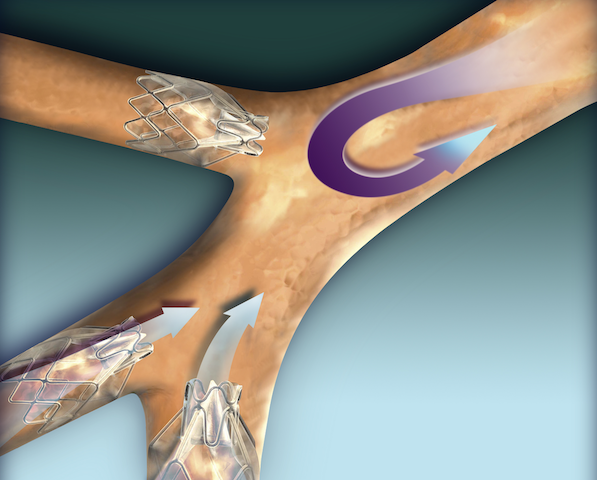Airway Stents
Airway stents are intraluminal prostheses placed endoscopically to support and maintain patency of the tracheobronchial tree affected by intrinsic or extrinsic disease. Because of their durability, cost, and ease of placement, MR-safe silicone stents are most widely used for benign disease. Metal stents are most frequently used to treat airway strictures and compression due to malignant disease.
|
The earliest all-metal airway stents (Gianturco, Wallstent, Palmaz) were made of stainless steel and were repurposed models originally designed for use in the vascular or gastrointestinal systems. Although still available, most modern metal stents are made of non-ferromagnetic alloys, especially Nitinol™ (Ni-Ti) or Elgiloy® (Co-Cr-Ni-Mo). They may be uncovered (bare metal) or covered (with a layer of silicone or plastic). Although not all metallic stents have undergone rigorous testing, they should be viewed as MR Conditional at least up to 3.0T without significant worries concerning heating or displacement. Expect the stainless steel stents to produce considerable MR artifact, however.
|
I am aware of only one currently manufactured airway stent declared MR Unsafe by its manufacturer, the stainless steel Boston Scientific Dynamic™ (Y) Tracheobronchial Stent. Because the stent is tightly positioned with arms extending into both main stem bronchi, the chance of magnetic field movement/dislodgment would seem small. The stainless steel tracheal supports are not even complete rings, but have a "C"-shape. Perhaps this is just another example of a manufacturer choosing to be overly cautious with regard to MR safety.
Endobronchial valves
Endobronchial valves (EBVs) are one-way devices placed endoscopically for treatment of emphysema and postoperative air leaks. The two main brands are the Emphasys Zephyr® (Pulmonx, Inc) and the Spiration® IBV System (Olympus Medical). Both have nonferromagnetic Nitinol (Ni-Ti) arms covered with plastic or silicone and are MR Conditional up to 3.0T.

"MR Conditional" Zephyr® EBVs restrict filling of distal bronchi during inspiration only. (By Pulmonx, Inc., CC BY-SA 3.0, Link)
|
|
Endobronchial Coils
Endobronchial coils are endoscopically delivered to irreversibly occlude airways in patients with severe emphysema. About a dozen coils are typically deployed for each target lobe. Contraction of lung parenchyma occurs with reduction in lung volume and (theoretically) improved pulmonary function.
I am aware of only a single endobronchial coil system — the PneumRx Elevair® (Boston Scientific) — available in Europe but which recently failed to receive FDA-approval. The coils are made of shape-memory Nitinol and are MR Conditional up to 3T. |
Advanced Discussion (show/hide)»
No supplementary material yet. Check back soon!
References
"Endobronchial Valve", From Wikepedia, The Free Encyclopedia.
Folch E, Keyes C. Airway stents. Ann Cardiothorac Surg 2018; 7:273-283. [DOI LINK]
Slebos D-J, ten Hacken NH, Hetze M, et al. Endobronchial coils for endoscopic lung volume reduction: best practice recommendations from an expert panel. Respiration 2018; 96:1-11. [DOI LINK]
van Geffen WH, Kerstjens HAM, Slebos D-J. Emerging bronchoscope treatments for chronic obstructive pulmonary disease. Pharmacol Therapeutics 2017; 179:96-101. [DOI LINK]
Xia Y, Jin R, Li W, Shen H. Magnetic resonance imaging of patients with airway stents. J Thor Dis 2018; 10:5939-5945. [DOI LINK]
"Endobronchial Valve", From Wikepedia, The Free Encyclopedia.
Folch E, Keyes C. Airway stents. Ann Cardiothorac Surg 2018; 7:273-283. [DOI LINK]
Slebos D-J, ten Hacken NH, Hetze M, et al. Endobronchial coils for endoscopic lung volume reduction: best practice recommendations from an expert panel. Respiration 2018; 96:1-11. [DOI LINK]
van Geffen WH, Kerstjens HAM, Slebos D-J. Emerging bronchoscope treatments for chronic obstructive pulmonary disease. Pharmacol Therapeutics 2017; 179:96-101. [DOI LINK]
Xia Y, Jin R, Li W, Shen H. Magnetic resonance imaging of patients with airway stents. J Thor Dis 2018; 10:5939-5945. [DOI LINK]
Related Questions
Can patients with ET tubes and other upper airway devices undergo MRI?
Can patients with ET tubes and other upper airway devices undergo MRI?



